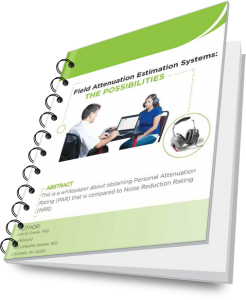Noise Reduction Rating (NRR)
Hearing protectors are labeled with a Noise Reduction Rating (NRR) that is derived from laboratory measurements of the attenuation provided to trained and motivated human subjects in a ‘sterile’ environment. As intended, these measurements represent a best-fit condition. The literature indicates that the average attenuation provided to end-users of hearing protectors is often only a fraction of the labeled values. To learn more about the practical alternative to relying on the NRR, click here.
Custom Protect Ear would like to present a FREE WHITEPAPER about obtaining Personal Attenuation Rating (PAR) that is compared to Noise Reduction Rating (NRR).
Field Attenuation Estimation Systems: THE POSSIBILITIES
Would it be nice if you could determine how effective a hearing protector was under workplace conditions. In Appendix  IV:C of the OSHA Field Manual, Methods for Estimating HPD Attenuation, U.S. OSHA states, “The actual effectiveness of any individual hearing protector cannot be determined under workplace conditions” (U.S.Department of Labor). This has never been completely true. It has been difficult, but not impossible, to determine the actual effectiveness of any individual hearing protector for any individual user because of two issues. First, there has been no available commercial product for testing hearing protector effectiveness for the individual user until just recently – for less than 10 years compared to an OSHA regulation on noise and hearing conservation that dates back almost 45 years in its most skeletal form. Second, there have been no accessible commercial methods for determining the effectiveness of any individual hearing protector for any individual until recently. In fact, now there are three:
IV:C of the OSHA Field Manual, Methods for Estimating HPD Attenuation, U.S. OSHA states, “The actual effectiveness of any individual hearing protector cannot be determined under workplace conditions” (U.S.Department of Labor). This has never been completely true. It has been difficult, but not impossible, to determine the actual effectiveness of any individual hearing protector for any individual user because of two issues. First, there has been no available commercial product for testing hearing protector effectiveness for the individual user until just recently – for less than 10 years compared to an OSHA regulation on noise and hearing conservation that dates back almost 45 years in its most skeletal form. Second, there have been no accessible commercial methods for determining the effectiveness of any individual hearing protector for any individual until recently. In fact, now there are three:
- There are methods involving simulations of the real-ear attenuation at threshold (REAT) using large-cupped earphones to place over the ears to test earplugs. (Michael and Associates FitCheck, Workplace INTEGRA, Inc. INTEGRAfit, NIOSH Well-Fit and FitCheck Solo)
- There are methods involving having a person balance the loudness of a signal presented to an open ear to that of a signal presented to an ear occluded with an earplug.
- There are methods that employ the use of a sub-miniature or probe microphone placed in a surrogate protector to predict what attenuation a user would receive when wearing the actual hearing protector in a similar manner.